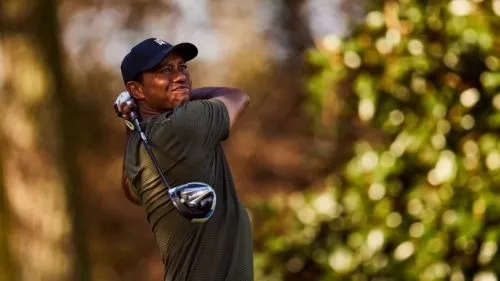Looking Back at Tiger’s 2020 Master’s Win – What Makes it So Incredible?


Significance comes with time, at least normally. Seldom does a sporting moment cut through on a deeper level instantly. It is hindsight that allows us to appreciate the gravity of a situation. There are, though, exceptions—goosebump-inducing episodes that immediately convey unmistakable import. Jeter’s last hit at Yankee Stadium. The Miracle on Ice. Tiger’s first Masters win. Tiger’s last Masters win.
Twenty-two years after Woods showed the world what its next sporting icon looked like, and 18 months after he reminded the world to never count him out, Tiger played a seven-hole stretch that falls into both categories: remarkable in the moment and more so, perhaps, with the passage of time. On that gray autumnal Sunday, those seven holes felt poetic. Given the events of the 12 months since, they’re downright eerie.
One Year Ago
The 2020 Masters, played in November due to the COVID-19 pandemic, feels in many ways like it took place a decade ago. You’ll recall that Woods wasn’t anywhere near the lead; his game couldn’t keep pace with the galloping horse that was Dustin Johnson that week. This wasn’t about the score he posted on Sunday, a four-over 76 that saw him finish 19 back of DJ. It was how he got to that number.
Woods had seen his round sputter before he stepped to the par-3 12th hole, Augusta National’s iconic nook that, one year earlier, hoodwinked his competition and handed him a most unlikely victory. In turn, he proceeded to make the same mistake that Poulter and Brooksy and Tony and Francesco made, misjudging the wind and spinning one back into Rae’s Creek.
He then dropped and made the same mistake Jordan made by failing to find dry land with his third. His fifth found the back bunker, his sixth the water again, his eighth the green. Two putts from there added up to a septuple-bogey 10. It wasn’t just his worst-ever score at the Masters; it was the worst of his entire career. Woods had played 23,789 holes on the PGA Tour without venturing into double digits. Of course, it happened on the hole that proved pivotal in perhaps the craziest victory of an amazing career.
Augusta has always had a flair for drama, but this approached a different level of tragic irony. Father Time had prevailed once again. The shots were ugly. The movements between them were downright cringeworthy. After playing his eighth shot from the sand, he searched for the least-painful way to pull himself out of the bunker before ultimately using his wedge as a cane. He was a beaten man.
On Your Own
Until he wasn’t.
“This sport is awfully lonely sometimes,” Woods said that day. “You have to fight it. No one is going to bring you off the mound or call in a sub. You have to fight through it.”
What happened next defied belief. It probably shouldn’t have, but it did. Woods was nine over for the round when he made the uphill climb to the 13th tee, and he was limping toward the worst round of his Masters career. Hell, the guy had serious work to do to break 80. He proceeded to rip a tight draw around the corner, quite possibly his best drive of the week, and two-putted for birdie. Another birdie at 15. And 16. And 17. And, for good measure, one more on 18.
He had never finished a round with five birdies over his last six holes. He had certainly never made five birdies in his last six holes after an embarrassing episode on perhaps golf’s most famous hole. Woods had a genuine smile on his face when he slipped the green jacket onto DJ’s broad shoulders. That finishing flourish washed away a vile aftertaste. You’ll never see a more impressive 76.
“That round was a monument to Woods’ competitive instincts,” says longtime golf writer Alan Shipnuck. “When he plays his best golf it is a wonder to behold. But it’s actually more riveting when he’s struggling. I’m not sure any player has ever fought as hard for every single stroke. The birdie binge had little to do with his proficiency at golf. It was all heart.”
Never Giving Up
Woods’ right-hand man/swing consultant/business partner/best pal, Rob McNamara, puts it more succinctly: “He just simply never gives up.”
We’re not going to compare a bad golf hole to the gauntlet that has been Woods’ last 12 months. December brought a fifth back surgery (remember that?), and February a harrowing car accident. Anyone who’s seen the wreckage knows Woods is lucky to be alive. He has done his best to avoid the spotlight since. He’s provided only vague updates on his progress and his future. He has not appeared or spoken publicly even once.
But this is 2021, and he is Tiger Woods, and so clandestine images and Bigfoot-like videos have surfaced. He’s walking in the latest one. There’s only a hint of a limp. He has returned to his favorite spot: a few yards behind Charlie, watching his son swing a golf club. He is, by all accounts, extraordinarily grateful to simply be a dad again.
No Return in Sight
He may never play another round of competitive golf again. The man himself has not said a single thing about a potential comeback. But with each additional grainy clip that surfaces and each first-hand account we hear from his pals …
“His competitive side is not going to let him hang it up without at least giving it a try,” said Justin Thomas on the No Laying Up podcast. JT’s in that extra-exclusive inner circle, seeing Tiger three times a week when he’s home in Jupiter
“I know how determined he is, and I know he’s going to at least try to give something again.”
Woods could so easily have played those last six holes in a few over, signed for 83, complained of a deteriorating body and faded into the background. No one would’ve blamed him. But, as McNamara conveyed, the man simply does not quit. And while Woods’ body could well prevent him from returning to the arena—he is, after all, a 45-year-old with a fused back and a bum knee, coming off a traumatic leg injury—one needs only to think back to the events of that Sunday afternoon for a definitive illustration of Woods’ fighting spirit. He would not go quietly then. Why would he now?
Read the original article on Golf Digest.



